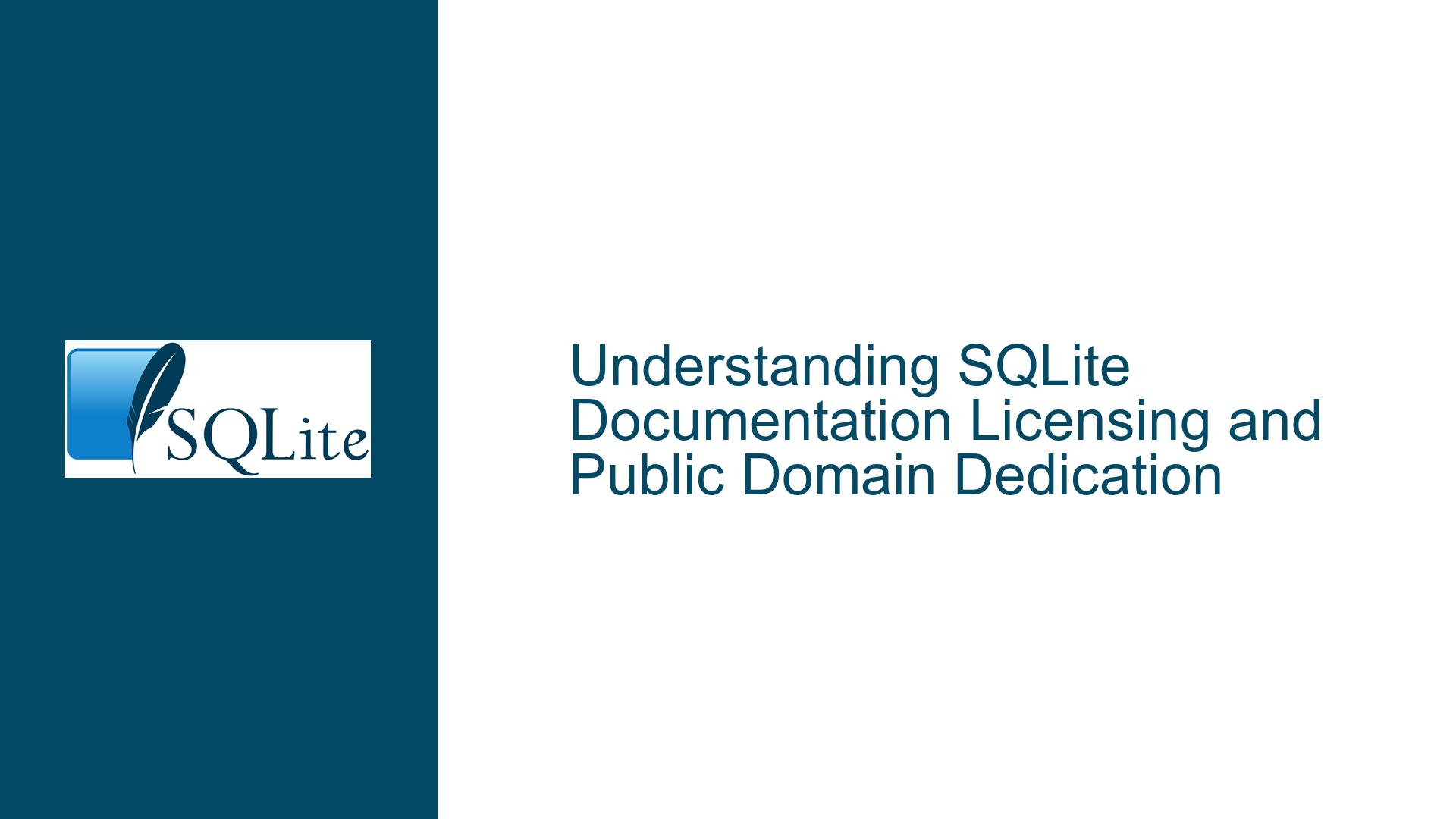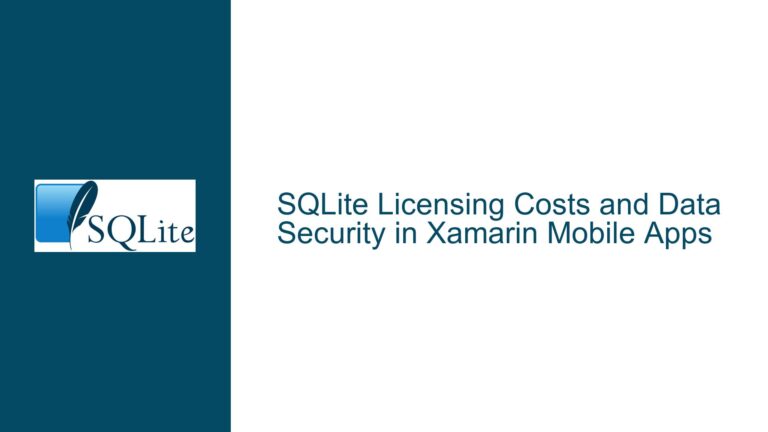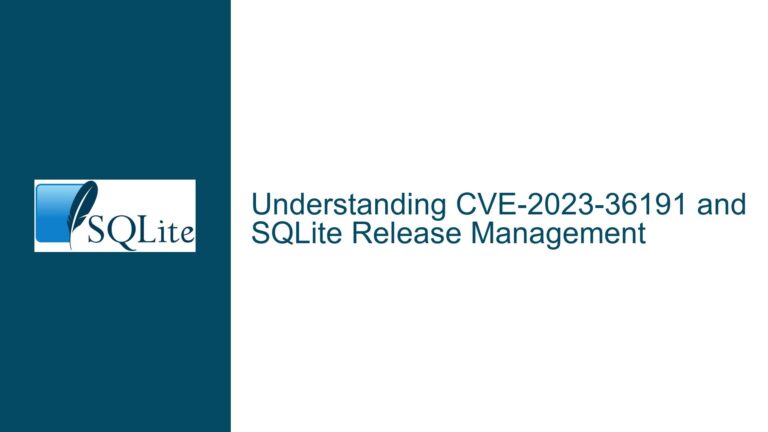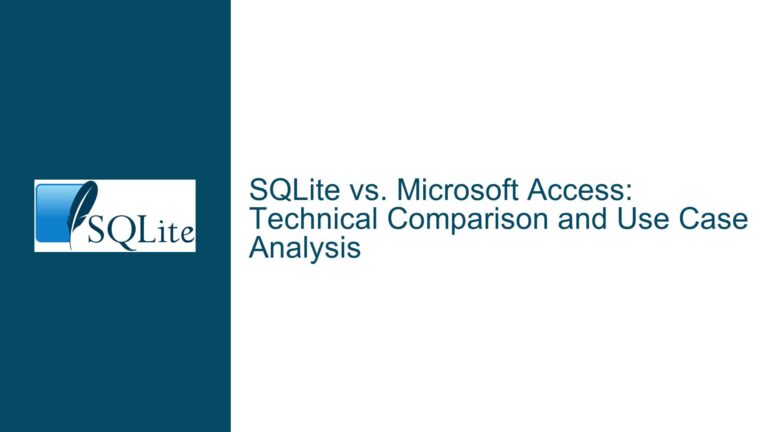SQLite Documentation Licensing and Public Domain Dedication
SQLite Documentation Licensing: Public Domain Dedication and Clarifications
Issue Overview: SQLite Documentation Licensing Status and Public Domain Dedication
The core issue revolves around the licensing status of SQLite documentation and whether it is explicitly dedicated to the public domain, similar to the SQLite source code. SQLite is widely known for its public domain dedication, which allows unrestricted use, modification, and distribution of its source code. However, the documentation’s licensing status has been a point of confusion for users, as it is not immediately clear whether the same public domain dedication applies to the documentation. This confusion stems from the absence of a specific license file or statement explicitly addressing the documentation’s licensing terms.
The SQLite documentation is a critical resource for developers, providing detailed explanations of SQLite’s features, APIs, and usage patterns. It is built from source files and hosted on the SQLite website, which is generated from a documentation source repository. Despite its importance, the licensing terms for the documentation have not been as prominently highlighted as those for the source code. This has led to questions about whether the documentation is also in the public domain or if it is subject to different licensing terms.
The SQLite copyright page (https://www.sqlite.org/copyright.html) explicitly states that "All of the code and documentation in SQLite has been dedicated to the public domain by the authors." This statement clarifies that both the source code and the documentation are in the public domain. However, the lack of a dedicated LICENSE.txt file or similar documentation-specific licensing statement in the documentation repository has contributed to the uncertainty. This issue highlights the importance of clear and accessible licensing information for all components of a project, especially for widely used resources like SQLite.
Possible Causes: Ambiguity in Documentation Licensing and Repository Structure
The ambiguity surrounding the SQLite documentation’s licensing status can be attributed to several factors. First, the documentation is generated from source files stored in a separate repository, which may not have included a clear licensing statement. While the SQLite source code repository prominently features its public domain dedication, the documentation repository may not have had an equivalent LICENSE.txt file or similar declaration. This discrepancy can lead to confusion, as users may assume that the absence of a licensing statement implies different terms for the documentation.
Second, the SQLite website, which hosts the documentation, is built from the documentation source repository. The website itself does not prominently display licensing information for the documentation, further contributing to the uncertainty. Users who rely on the website for documentation may not immediately find information about the documentation’s licensing status, leading them to question whether it is covered by the same public domain dedication as the source code.
Third, the SQLite copyright page, which explicitly states that both the code and documentation are in the public domain, may not be easily discoverable for all users. While the page provides a clear statement, it is not directly linked from the documentation pages or the documentation repository. This lack of visibility can result in users overlooking the copyright page and its clarification about the documentation’s public domain status.
Finally, the process of generating the documentation from source files may introduce additional complexity. If the documentation source files do not include licensing information, the generated documentation may also lack this information. This can create a disconnect between the source files and the final documentation, making it difficult for users to determine the licensing terms.
Troubleshooting Steps, Solutions & Fixes: Clarifying Documentation Licensing and Improving Accessibility
To address the ambiguity surrounding the SQLite documentation’s licensing status, several steps can be taken to clarify the terms and improve accessibility. First, a LICENSE.txt file or similar licensing statement should be added to the documentation source repository. This file should explicitly state that the documentation is dedicated to the public domain, consistent with the SQLite source code. Including this file in the repository will ensure that users who access the documentation source files can easily find the licensing information.
Second, the SQLite website should prominently display licensing information for the documentation. This can be achieved by adding a link to the copyright page from the documentation pages or including a brief licensing statement directly on the documentation pages. By making the licensing information more visible, users will be able to quickly determine that the documentation is in the public domain.
Third, the SQLite copyright page should be updated to include a more detailed explanation of the documentation’s public domain status. While the current statement is clear, providing additional context about the documentation’s inclusion in the public domain dedication can help alleviate any remaining confusion. This update should also include information about how the documentation is generated and how users can verify its public domain status.
Fourth, the documentation generation process should be reviewed to ensure that licensing information is included in the final documentation. If the documentation source files do not currently include licensing information, this should be added to the source files. The generation process should then be updated to include this information in the final documentation, ensuring that users who access the documentation through the website or other channels can easily find the licensing terms.
Finally, the SQLite community should be informed about these updates to ensure that users are aware of the documentation’s public domain status. This can be achieved through announcements on the SQLite website, forum posts, and updates to the documentation itself. By proactively communicating these changes, the SQLite team can help prevent future confusion and ensure that users have the information they need to use the documentation confidently.
In conclusion, the SQLite documentation’s licensing status is clarified by the public domain dedication stated on the SQLite copyright page. However, the lack of a dedicated LICENSE.txt file in the documentation repository and the absence of prominent licensing information on the documentation pages have contributed to confusion. By adding a LICENSE.txt file to the documentation repository, improving the visibility of licensing information on the SQLite website, updating the copyright page, ensuring that licensing information is included in the generated documentation, and communicating these changes to the community, the SQLite team can resolve this issue and provide users with clear and accessible licensing information.






